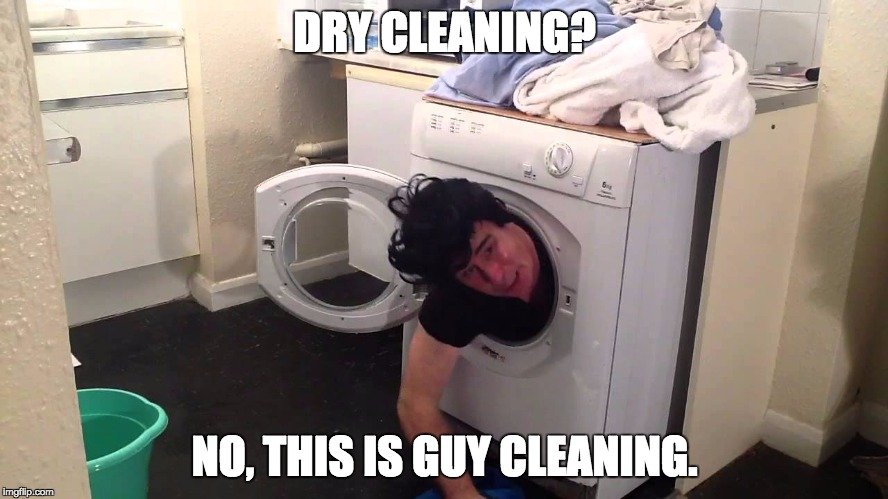How To Run A Dry Cleaning Business
When people drop off their clothes at the dry out cleaner, they don't tend to hang around and ask the workers what sort of magic they wield to eliminate tough stains from the about frail fabrics. Most customers only come back 2-3 days later on, expecting a perfectly pressed and cling film-covered outfit that is crisp and ready to wearable. However, dry cleaners are not magicians, and the process of dry cleaning is surprisingly elementary. The question is, how does it actually work?

Short Reply: Rather than using water, dry cleaning relies on a different non-water-based solvent to remove stains, followed past additional processing and pressing to proceed delicate clothes looking brand new.
Recommended Video for you:
The Scientific discipline of Dry Cleaning
As most of you know, cleaning your clothes in a regular washing machine is perfectly acceptable for well-nigh types of dress, provided you go on the colors separate. Later on loading them into the washing motorcar and adding detergent, water slowly filters in and the machine begins to churn, eliminating stains through friction and the furnishings of water equally a universal solvent. However, not all substances are water-soluble, pregnant that regular washing won't be able to eliminate them from your wearing apparel. Furthermore, sure types of material do not react well with h2o, so they shouldn't be put into a washing automobile. This is where dry cleaning comes in.
The foundation of dry cleaning is the apply of a petroleum solvent, rather than relying on water. The first person to recognize the potential of a petroleum solvent lived roughly two centuries agone, and accidentally discovered dry cleaning past spilling kerosene on a greasy particular of wear. Seeing that the pesky stain was eliminated, he established the start dry out-cleaning service in Paris afterward experimenting with different petroleum-based substances.
Today, the same tradition is largely intact, considering there is no water in petroleum, so those delicate fabrics are protected while they are being cleaned. However, kerosene is extremely combustible, so in the past 200 years, many other options have been adult. Most notably – and most popularly for decades – perchloroethylene was used for many years because it was non flammable and highly effective. Affectionately shortened to "perc", even this solution was constitute to be potentially hazardous – and carcinogenic – then for the by two decades, new dry-cleaning solvents have been growing in popularity.

The Process of Dry Cleaning
Much like a regular washing machine, your delicate suits, dresses and ties are added to a front-loading washer, but instead of adding water to the machine, the petroleum-based chemical is added. The fabric is tumbled, relying on friction to scrub out the difficult stains with the "perc" or other solvent.
Afterward a certain amount of time, an extractor removes this chemical from the clothes and machine, along with the dirt and grime, leaving your dress perfectly clean. The solvent is then converted back from liquid into gas, meaning that it tin can exist reused – a major benefit for dry-cleaning companies, in terms of cost.
Unfortunately, this "dry" cleaning process doesn't remove every stain, so pocket-sized amounts of "moisture" or "dry out" spot-removing agents are applied by hand for the toughest spots. Following this, your well-nigh precious clothes are sent through a high-powered pressing machine, which provides the well-baked edges and "make-new" feeling to your dry-cleaned clothes.
Why Can Some Things Not Be Dry Cleaned?
Every bit mentioned higher up, certain materials are not recommended for traditional washing, such as cashmere, wool, silk, muslin, suede, soft leathers and clothes with intricate embroidery or beadwork.
For some of these materials, the employ of water causes the fibers to denature and loosen, and it can be difficult (or impossible) for them to assume their original shape. This is true for wool and silk, especially if the article of clothing is composed of more than 60% of those cobweb types.
When it comes to muslin, the fabric is simply too delicate for the rigors of a regular washing car, and would probable tear in the process, rendering it useless.
For suede and soft leather items, stains tin exercise pregnant or permanent impairment, but adding water could practice more than impairment or upshot in spotting of the fabric. Dry cleaning is required to lift the stain without making things worse. However, certain types of suede crave even more than careful processing, and then only select dry-cleaning establishments can handle the job.
Finally, if your dress are intricately woven, embroidered or contain beads, sequins etc., you lot will need to use a dry cleaner because the vigorous rubbing and friction of a traditional water will likely impairment or tear the fabric. In this example, you besides desire to go to an experience dry cleaner that you trust, as even dry cleaning can do damage to these frail items.
Dry Cleaning in the Time to come
Petroleum-based solvents have worked for centuries now, but there are always advancements, even in this rather static field. Some of the newest ideas for dry out cleaning include the use of CO2 as a solvent, which has proven to be extremely effective and much less dangerous for employees of dry cleaners than using the carcinogenic "perc". Unfortunately, the mechanism needed to convert CO2 from gas into liquid is expensive, then this is only available in select, high-end dry cleaning establishments.
The merely thing we know for sure is that people will always have fancy weddings to go to, likewise as delicate clothes that demand to look pristine for the big day. Where there is a demand – even in the seemingly slow world of dry cleaning – innovation is bound to follow!
Assistance us make this article amend
Source: https://www.scienceabc.com/innovation/how-does-dry-cleaning-work.html
Posted by: turnerfrougglighth.blogspot.com


0 Response to "How To Run A Dry Cleaning Business"
Post a Comment